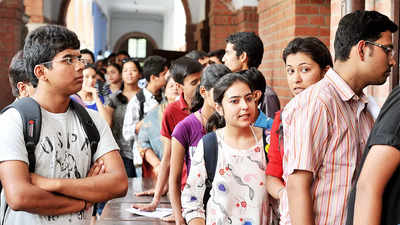
The 12th edition of the Annual Status of Higher Education (ASHE) report, published in 2024, brings forth a comprehensive analysis of India’s higher education landscape, using data from the All-India Survey of Higher Education (AISHE), as well as inputs from the CII Higher Education Committee and Deloitte. This year’s report is of particular significance as it arrives at a crucial juncture, amidst various reforms and developments in the education sector.The internationalisation of Indian higher education, as one of the major focal points, is identified as a key driver for expansion, enhanced access, and improved quality. By expanding Gross Enrolment Ratio (GER) and improving educational quality, India aims to offer better opportunities to a wider pool of students. Telangana, as one of India’s most rapidly developing states in terms of higher education, features prominently in the report, with its progressive growth in enrolment, institutional development, and gender inclusivity.
The findings from Telangana, as presented in the ASHE 2024 report, provide a comprehensive snapshot of the state’s educational progress. The state has seen significant developments, especially in terms of improving the GER, increasing female enrolments, and diversifying its higher education infrastructure. Furthermore, Telangana’s growth trajectory highlights the role of the government and private institutions in shaping the educational ecosystem. The focus on enhancing access and quality aligns well with the national imperative to create an education system that caters to the evolving needs of the workforce and society. In this article, we will examine these observations in detail, comparing key indicators such as enrolment trends, GER, pupil-teacher ratio (PTR), and faculty-student dynamics, while also evaluating the long-term implications of these changes for both Telangana and the broader Indian education landscape.
Key Insights from Telangana’s Education Data
Growth in Gross Enrolment Ratio (GER): One of the most significant indicators of progress in higher education is the Gross Enrolment Ratio (GER), which measures the total enrolment in higher education as a percentage of the eligible population in the age group of 18-23 years. In Telangana, the GER has shown a substantial improvement, especially among female students. The GER for Telangana stands at 40.0%, with females at 41.6%, surpassing male enrolment, which stands at 38.5%. This marks a notable achievement in bridging the gender gap in education, a trend that is observed not only in Telangana but across the country.
Over the last few years, female GER has consistently outperformed male GER, rising from 34.2% in 2017-18 to 41.6% in 2021-22. This growth highlights the increasing participation of women in higher education, which is a key goal of India’s educational policies. Moreover, the share of Telangana’s 18-23 age group in the total Indian population in the same group is 2.9%, a reflection of the state’s pivotal role in the national higher education narrative. These statistics suggest that the state is not only increasing the number of students entering higher education but is also making substantial strides in ensuring equitable access to education for all genders.
Expansion of Educational Infrastructure and College Types: Telangana’s educational infrastructure has diversified significantly, with a wide range of universities and colleges catering to various academic specialisations. The state boasts a mix of public, private, and deemed universities, with 15 state public universities, 4 institutes of national importance, and 2 private deemed universities. This varied landscape provides students with diverse opportunities to pursue education across fields such as medical, technical, agriculture, and law, among others.
While engineering and technology courses dominate the educational landscape with 186 colleges, the state also offers a wide range of disciplines such as nursing (56 colleges), management (66 colleges), and education (97 colleges). The college distribution further reveals that 97.3% of colleges in Telangana are affiliated colleges, with only 2% being constituent or university colleges. This highlights the state’s reliance on affiliate colleges, which play a crucial role in providing access to higher education for a large number of students, albeit with varying degrees of autonomy and academic quality control.
Private vs. Government Colleges: A notable feature of Telangana’s higher education system is the dominance of private unaided colleges, which account for a significant 79.8% of the total number of colleges in the state. Despite their dominance, these colleges cater to 75.2% of the enrolment, suggesting that private institutions continue to play a vital role in the education system. In contrast, government colleges make up 14.6% of the total, serving 17.5% of the student population. The reliance on private institutions underscores the state’s increasing dependence on the private sector to meet the growing demand for higher education. This shift, however, comes with concerns about the quality and affordability of education, particularly in the absence of adequate regulation in the private sector.
Increasing Focus on Postgraduate Education and Professional Training: Another notable trend is the rise in postgraduate enrolments in Telangana. The number of postgraduate students has been steadily increasing, particularly in technical and medical fields. Postgraduate programmes in Telangana are witnessing a rise in female participation, with 92,350 females enrolled in postgraduate courses, compared to 70,558 males. This marks a significant change from the past, as postgraduate education was traditionally male-dominated in many fields. Furthermore, the increasing enrolment in PG Diploma courses reflects a shift towards more specialised, skill-based education, which is crucial in today’s job market.
At the same time, enrolments in diploma courses have been decreasing, indicating a shift towards more advanced forms of education such as PG Diplomas and undergraduate degrees. This shift suggests that students are increasingly looking towards higher levels of education to gain a competitive edge in the job market, especially in fields where specialised knowledge is valued.
Comparative Analysis of Time Series Data (2017-2022)
Enrolment at Various Levels (2017-2022): A time series analysis of enrolment trends from 2017-18 to 2021-22 reveals some critical patterns:
The total enrolment in higher education across all levels in Telangana has shown a steady increase from 1,371,419 in 2017-18 to 1,374,512 in 2021-22. Notably, undergraduate enrolments have remained the highest, followed by postgraduate and diploma enrolments. The increase in PG Diploma enrolments reflects the growing demand for skill-based education, which is a notable shift in the state’s educational focus.
Gross Enrolment Ratio (GER) (2017-2022): The GER for Telangana shows significant improvement, particularly for female students:
The GER for females increased steadily from 34.2% in 2017-18 to 41.6% in 2021-22, surpassing male GER, which stood at 38.5% in 2021-22. This indicates significant progress in gender inclusivity in higher education in Telangana, aligning with national trends towards improving female participation.
Pupil-Teacher Ratio (PTR) Trends (2017-2022): The Pupil-Teacher Ratio (PTR), which indicates the average number of students per teacher, is an important measure of the quality of education, as it affects teacher-student engagement. For Telangana, the PTR figures over the last five years indicate a relatively stable teaching capacity in relation to student numbers, with some slight fluctuations.
The PTR for Telangana has remained relatively consistent, showing a gradual decrease from 18 in 2017-18 to 16 in 2019-20, and then stabilising at 16 in both 2020-21 and 2021-22. This decrease reflects a growing effort to reduce the student-teacher ratio, which is often linked to improved teaching quality and personalised attention for students.
However, despite this positive trend, the PTR is still higher than the national average of 23, indicating that there is room for improvement in terms of the number of teachers available relative to the increasing student enrolment.
The gender-specific PTR data also reveals some interesting insights. In 2021-22, the PTR for female students was slightly lower at 29.2, compared to 30.5 for male students. This suggests that there may be slightly more engagement with female students in terms of the teaching staff, which could be attributed to gender-focused initiatives aimed at improving educational outcomes for women.

